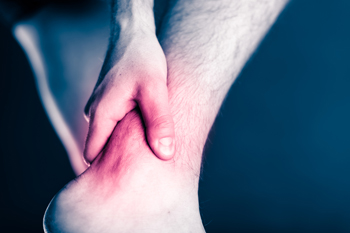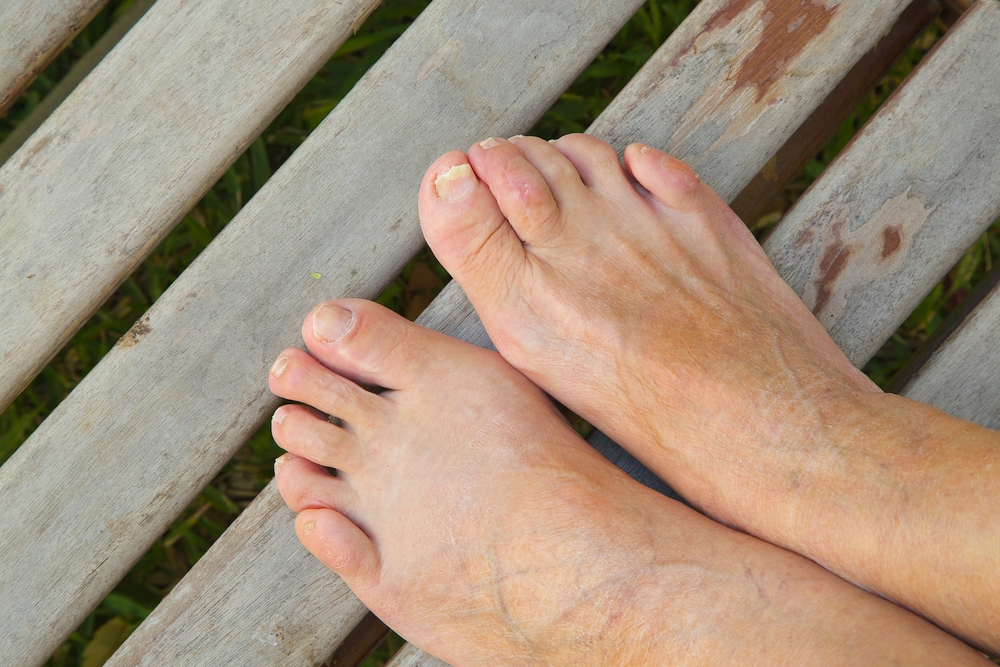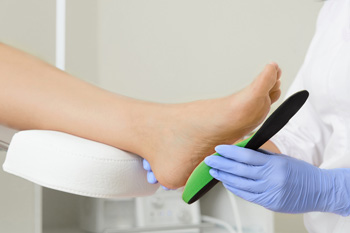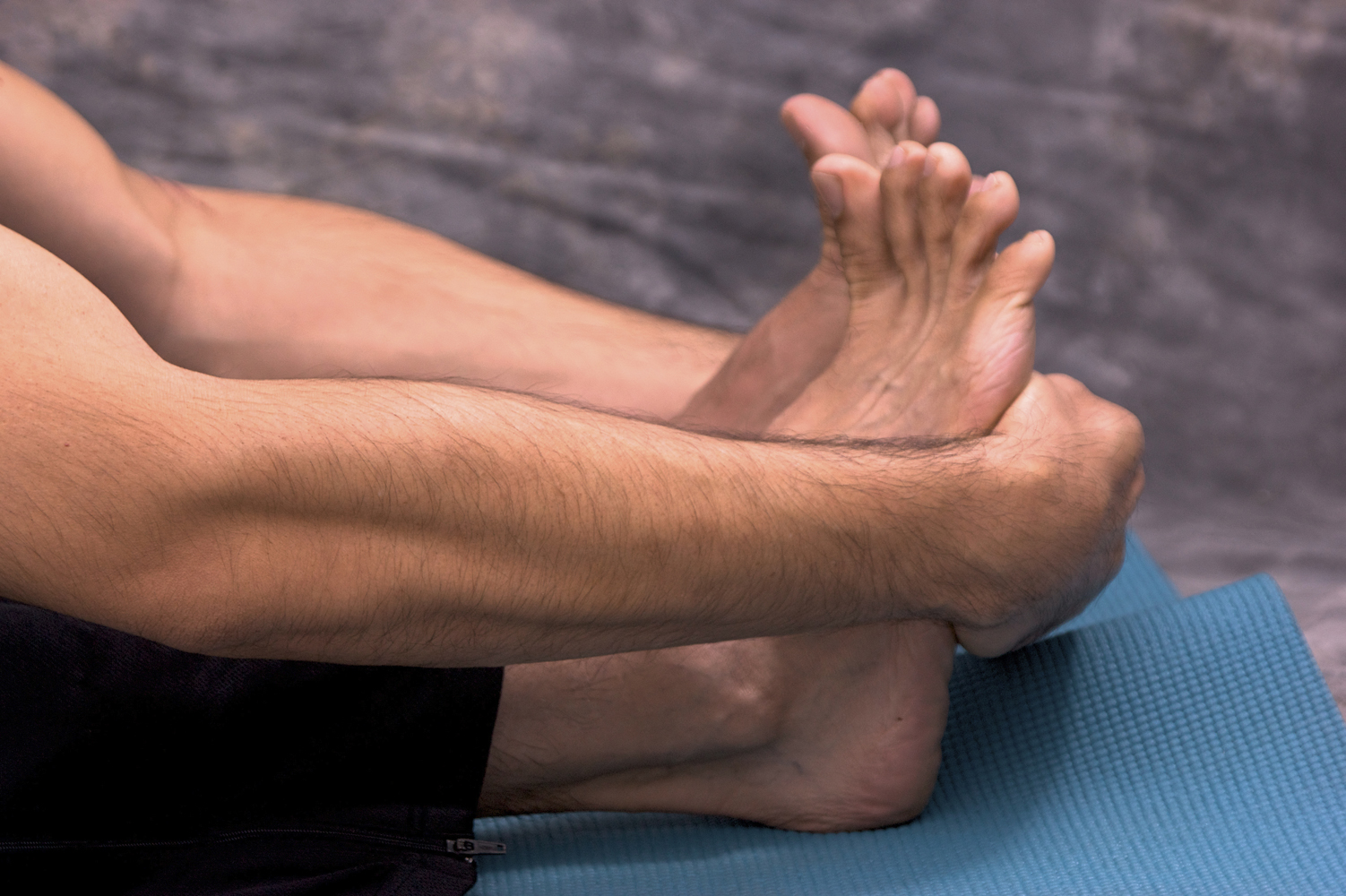
An ingrown toenail is easily distinguishable and is defined as a toenail that grows into the skin instead of over it. An ingrown toenail often causes severe pain and discomfort, and it can become infected. This foot condition can happen for a variety of reasons. Common causes can include wearing shoes that are too tight and trimming the toenails incorrectly. There are some patients who have family members with ingrown toenails, which may increase the risk of developing this ailment. Temporary relief may be found when the affected nail is soaked in warm water. This can soften the skin enough so that a small piece of cotton can be used while gently pulling the nail away from the skin. Permanent relief is often found with medical attention. If you have developed an ingrown toenail, it is strongly suggested that you seek the counsel of a podiatrist who can provide appropriate treatment options, which may include minor surgery.
Ingrown toenails may initially present themselves as a minor discomfort, but they may progress into an infection in the skin without proper treatment. For more information about ingrown toenails, contact one of our podiatrists of McKinney Podiatric Associates, PA. Our doctors can provide the care you need to keep you pain-free and on your feet.
Ingrown Toenails
Ingrown toenails are caused when the corner or side of a toenail grows into the soft flesh surrounding it. They often result in redness, swelling, pain, and in some cases, infection. This condition typically affects the big toe and may recur if it is not treated properly.
Causes
You are more likely to develop an ingrown toenail if you are obese, have diabetes, arthritis, or have any fungal infection in your nails. Additionally, people who have foot or toe deformities are at a higher risk of developing an ingrown toenail.
Symptoms
Some symptoms of ingrown toenails are redness, swelling, and pain. In rare cases, there may be a yellowish drainage coming from the nail.
Treatment
Ignoring an ingrown toenail can have serious complications. Infections of the nail border can progress to a deeper soft-tissue infection, which can then turn into a bone infection. You should always speak with your podiatrist if you suspect you have an ingrown toenail, especially if you have diabetes or poor circulation.
If you have any questions, please feel free to contact one of our offices located in Pasadena, Baytown, League City, Houston, and Pearland,TX . We offer the newest diagnostic and treatment technologies for all your foot care needs.

Active children and young teenagers may be prone to developing Sever’s disease. It is a condition that affects the growth plate in the heel and can cause severe pain and discomfort. The pain is felt in the heel, and one of the first signs parents may notice is their child is limping. Additionally, affected children may walk on their tiptoes to avoid putting pressure on the heel. The treatment for Sever’s disease can begin with temporarily stopping the activity that caused this condition, and frequently elevating the affected foot. It is beneficial to avoid walking on that foot, and it may help to wear a protective boot or to use crutches. Parents may find their children may benefit from practicing stretching techniques, which can help the heel and calf muscles. If your active child has heel pain, it is suggested that you schedule an appointment with a podiatrist who can effectively diagnose and treat Sever’s disease.
Sever's disease often occurs in children and teens. If your child is experiencing foot or ankle pain, see one of our podiatrists from McKinney Podiatric Associates, PA. Our doctors can treat your child’s foot and ankle needs.
Sever’s Disease
Sever’s disease is also known as calcaneal apophysitis, which is a medical condition that causes heel pain I none or both feet. The disease is known to affect children between the ages of 8 and 14.
Sever’s disease occurs when part of the child’s heel known as the growth plate (calcaneal epiphysis) is attached to the Achilles tendon. This area can suffer injury when the muscles and tendons of the growing foot do not keep pace with bone growth. Therefore, the constant pain which one experiences at the back of the heel will make the child unable to put any weight on the heel. The child is then forced to walk on their toes.
Symptoms
Acute pain – Pain associated with Sever’s disease is usually felt in the heel when the child engages in physical activity such as walking, jumping and or running.
Highly active – Children who are very active are among the most susceptible in experiencing Sever’s disease, because of the stress and tension placed on their feet.
If you have any questions, please feel free to contact one of our offices located in Pasadena, Baytown, League City, Houston, and Pearland,TX . We offer the newest diagnostic and treatment technologies for all your foot and ankle injuries.

A stiff and painful ankle is common after an ankle injury, such as an ankle sprain, fracture, or Achilles tendon tear. Stretching, mobilizing, and re-training can increase the mobility and functionality of the ankle. Patients are often put in a cast after an ankle injury, and while the immobilization helps with healing, it also creates swelling and inflammation. Dorsiflexion is important while walking and running, and occurs when the foot comes up towards the shin. This is one of the most frequent and limiting ranges of motion lost after an ankle problem. A quick, short-term option to relieve some of the stiffness is to wear shoes that have a heel or heel wedge. Longer term, it is suggested that you be under the care of a podiatrist who can help you with proper exercises and other relief options for stiff ankles.
Ankle pain can have many different causes and the pain may potentially be serious. If you have ankle pain, consult with one of our podiatrists from McKinney Podiatric Associates, PA. Our doctors will assess your condition and provide you with quality foot and ankle treatment.
Ankle pain is any condition that causes pain in the ankle. Due to the fact that the ankle consists of tendons, muscles, bones, and ligaments, ankle pain can come from a number of different conditions.
Causes
The most common causes of ankle pain include:
Symptoms
Symptoms of ankle injury vary based upon the condition. Pain may include general pain and discomfort, swelling, aching, redness, bruising, burning or stabbing sensations, and/or loss of sensation.
Diagnosis
Due to the wide variety of potential causes of ankle pain, podiatrists will utilize a number of different methods to properly diagnose ankle pain. This can include asking for personal and family medical histories and of any recent injuries. Further diagnosis may include sensation tests, a physical examination, and potentially x-rays or other imaging tests.
Treatment
Just as the range of causes varies widely, so do treatments. Some more common treatments are rest, ice packs, keeping pressure off the foot, orthotics and braces, medication for inflammation and pain, and surgery.
If you have any questions, please feel free to contact one of our offices located in Pasadena, Baytown, League City, Houston, and Pearland,TX . We offer the newest diagnostic and treatment technologies for all your foot care needs.

Hammertoe is a particular kind of affliction of the feet which primarily impacts the joints of the toes. An individual living with hammertoe will notice that the joint of their toe sticks up while the rest of the toe points downward. Many patients often confuse this condition with another known as claw toe. Claw toe is different and distinct from hammertoe in that patients with claw toe have unnatural bends in the last two joints of the toe. As a result, the entire toe curls downward. Therefore, hammertoe and claw toe create different shapes in the toes. If you are interested in preventing the onset of these different foot conditions, it is suggested that you contact a podiatrist immediately for any possible advice or treatment.
Hammertoe
Hammertoes can be a painful condition to live with. For more information, contact one of our podiatrists from McKinney Podiatric Associates, PA. Our doctors will answer any of your foot- and ankle-related questions.
Hammertoe is a foot deformity that affects the joints of the second, third, fourth, or fifth toes of your feet. It is a painful foot condition in which these toes curl and arch up, which can often lead to pain when wearing footwear.
Symptoms
Causes
Genetics – People who are genetically predisposed to hammertoe are often more susceptible
Arthritis – Because arthritis affects the joints in your toes, further deformities stemming from arthritis can occur
Trauma – Direct trauma to the toes could potentially lead to hammertoe
Ill-fitting shoes – Undue pressure on the front of the toes from ill-fitting shoes can potentially lead to the development of hammertoe
Treatment
Orthotics – Custom made inserts can be used to help relieve pressure placed on the toes and therefore relieve some of the pain associated with it
Medications – Oral medications such as anti-inflammatories or NSAIDs could be used to treat the pain and inflammation hammertoes causes. Injections of corticosteroids are also sometimes used
Surgery – In more severe cases where the hammertoes have become more rigid, foot surgery is a potential option
If you have any questions please contact one of our offices located in Pasadena, Baytown, League City, Houston, and Pearland,TX . We offer the newest diagnostic and treatment technologies for all your foot and ankle needs.

Orthotics are shoe inserts that help redistribute pressure, improve gait and posture, and cushion sensitive parts of the feet. The can also help to absorb shock and reduce foot pain. People with certain conditions that can benefit from orthotics include plantar fasciitis, lower limb injuries, flat feet or high arches. Patients with pronation or supination may also find a better distribution of pressure and equilibrium when orthotics are worn. Most people seem to benefit while some kind of orthotic is worn, either custom-made inserts or those that can be purchased over-the-counter. If you would like to know more about this pain-saving device, it is suggested that you visit a podiatrist to see if you are a good candidate for custom orthotics.
If you are having discomfort in your feet and would like to try orthotics, contact one of our podiatrists from McKinney Podiatric Associates, PA. Our doctors can provide the care you need to keep you pain-free and on your feet.
What Are Orthotics?
Orthotics are inserts you can place into your shoes to help with a variety of foot problems such as flat feet or foot pain. Orthotics provide relief and comfort for minor foot and heel pain but can’t correct serious biomechanical problems in your feet.
Over-the-Counter Inserts
Orthotics come in a wide variety of over-the-counter inserts that are used to treat foot pain, heel pain, and minor problems. For example, arch supports can be inserted into your shoes to help correct overarched or flat feet, while gel insoles are often used because they provide comfort and relief from foot and heel pain by alleviating pressure.
Prescription Orthotics
If over-the-counter inserts don’t work for you or if you have a more severe foot concern, it is possible to have your podiatrist prescribe custom orthotics. These high-quality inserts are designed to treat problems such as abnormal motion, plantar fasciitis, and severe forms of heel pain. They can even be used to help patients suffering from diabetes by treating foot ulcers and painful calluses and are usually molded to your feet individually, which allows them to provide full support and comfort.
If you are experiencing minor to severe foot or heel pain, it’s recommended to speak with your podiatrist about the possibilities of using orthotics. A podiatrist can determine which type of orthotic is right for you and allow you to take the first steps towards being pain-free.
If you have any questions please contact one of our offices located in Pasadena, Baytown, League City, Houston, and Pearland,TX . We offer the newest diagnostic and treatment technologies for all your foot and ankle needs.

Individuals might choose to stretch their feet for any number of reasons. This is because stretching the feet offers a range of different health benefits. For example, some individuals opt to incorporate foot stretches into their daily health routine because they can increase flexibility, mobility, and range of motion in the feet. Additionally, others choose to stretch their feet because of the soothing capacity of the stretches. In other words, stretching the feet can soothe pain. Pain felt from plantar fasciitis in particular can be soothed by performing certain foot stretches. Rolling the bottoms of the feet on a frozen water bottle can effectively stretch out and soothe the plantar fascia. If you are someone that wants to soothe foot pain through stretches, it is suggested that you contact a podiatrist for treatment.
Stretching the feet is a great way to prevent injuries. If you have any concerns with your feet consult with one of our podiatrists from McKinney Podiatric Associates, PA. Our doctors will assess your condition and provide you with quality foot and ankle treatment.
Stretching the Feet
Being the backbone of the body, the feet carry your entire weight and can easily become overexerted, causing cramps and pain. As with any body part, stretching your feet can serve many benefits. From increasing flexibility to even providing some pain relief, be sure to give your feet a stretch from time to time. This is especially important for athletes or anyone performing aerobic exercises, but anyone experiencing foot pain or is on their feet constantly should also engage in this practice.
Great ways to stretch your feet:
Individuals who tend to their feet by regular stretching every day should be able to minimize foot pain and prevent new problems from arising.
If you have any questions, please feel free to contact one of our offices located in Pasadena, Baytown, League City, Houston, and Pearland,TX . We offer the newest diagnostic and treatment technologies for all your foot care needs.

Poor circulation can cause tingling sensations, and the feet may feel cold. This generally occurs in the feet and may happen from sitting with the legs crossed for extended periods. Poor circulation can occur from medical conditions like high blood pressure, heart disease, and obesity. It may also happen from smoking, eating unhealthy foods, or from leading a sedentary lifestyle. Blood flow may be disrupted if there is an injury to the foot, and poor circulation may develop as the wound heals. This condition may be remedied when a healthy lifestyle is chosen, including engaging in a gentle exercise routine and eating foods that are low in fat. If you have symptoms of poor circulation, it is strongly suggested that you speak with a podiatrist who can help you to manage this condition.
While poor circulation itself isn’t a condition; it is a symptom of another underlying health condition you may have. If you have any concerns with poor circulation in your feet contact one of our podiatrists of McKinney Podiatric Associates, PA. Our doctors will treat your foot and ankle needs.
Poor Circulation in the Feet
Peripheral artery disease (PAD) can potentially lead to poor circulation in the lower extremities. PAD is a condition that causes the blood vessels and arteries to narrow. In a linked condition called atherosclerosis, the arteries stiffen up due to a buildup of plaque in the arteries and blood vessels. These two conditions can cause a decrease in the amount of blood that flows to your extremities, therefore resulting in pain.
Symptoms
Some of the most common symptoms of poor circulation are:
Treatment for poor circulation often depends on the underlying condition that causes it. Methods for treatment may include insulin for diabetes, special exercise programs, surgery for varicose veins, or compression socks for swollen legs.
As always, see a podiatrist as he or she will assist in finding a regimen that suits you. A podiatrist can also prescribe you any needed medication.
If you have any questions, please feel free to contact one of our offices located in Pasadena, Baytown, League City, Houston, and Pearland,TX . We offer the newest diagnostic and treatment technologies for all your foot care needs.

A small calcium deposit that forms between the heel and the arch of the foot may indicate a heel spur. It may happen as a result of an underlying health condition or possibly from wearing shoes that do not fit correctly. A heel spur can vary in shape, including pointed, hooked, or shelf-like, and can be up to a half-inch long. It can extend to the middle of the foot and cause the plantar fascia to become painful. A heel spur may occur from the natural aging process when the heel pads do not provide adequate shock absorption as they wear down. The symptoms include sharp heel pain, which may be more prominent in the morning, and the heel may be swollen and inflamed. An X-ray is generally performed that can provide an accurate diagnosis, and this can be followed by beginning treatment. If you have a heel spur, it is suggested that you confer with a podiatrist who can offer you relief options.
Heel spurs can be incredibly painful and sometimes may make you unable to participate in physical activities. To get medical care for your heel spurs, contact one of our podiatrists from McKinney Podiatric Associates, PA. Our doctors will do everything possible to treat your condition.
Heels Spurs
Heel spurs are formed by calcium deposits on the back of the foot where the heel is. This can also be caused by small fragments of bone breaking off one section of the foot, attaching onto the back of the foot. Heel spurs can also be bone growth on the back of the foot and may grow in the direction of the arch of the foot.
Older individuals usually suffer from heel spurs and pain sometimes intensifies with age. One of the main condition's spurs are related to is plantar fasciitis.
Pain
The pain associated with spurs is often because of weight placed on the feet. When someone is walking, their entire weight is concentrated on the feet. Bone spurs then have the tendency to affect other bones and tissues around the foot. As the pain continues, the feet will become tender and sensitive over time.
Treatments
There are many ways to treat heel spurs. If one is suffering from heel spurs in conjunction with pain, there are several methods for healing. Medication, surgery, and herbal care are some options.
If you have any questions feel free to contact one of our offices located in Pasadena, Baytown, League City, Houston, and Pearland,TX . We offer the latest in diagnostic and treatment technology to meet your needs.